Best Public Speaking Apps for the Samsung Gear Vr UPDATED
Best Public Speaking Apps for the Samsung Gear Vr
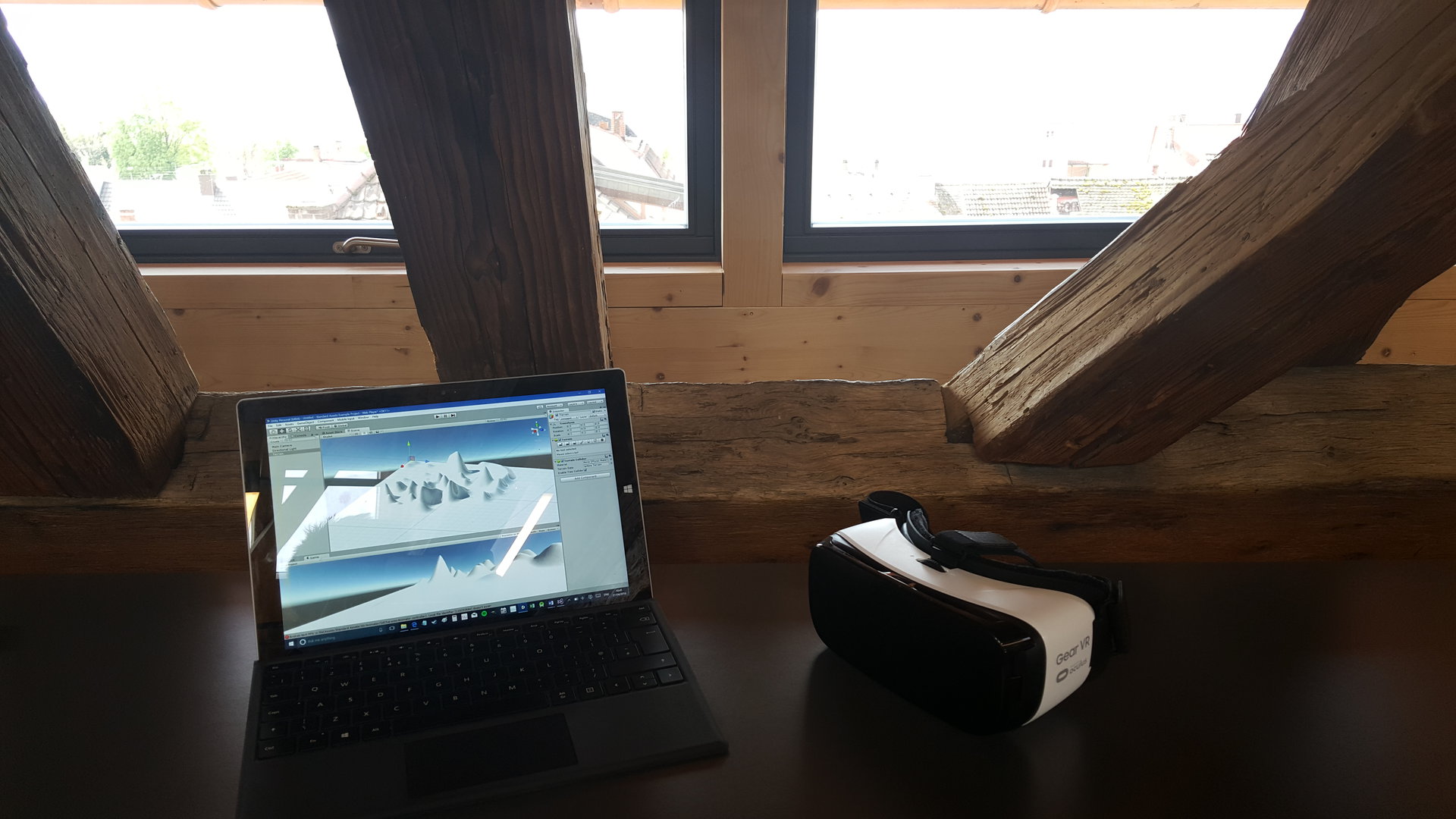
I of the most exciting parts of beingness a developer is being able to build your own tool or game so experience it for yourself for the first time. Just creating a mobile game or a productivity tool pales in comparison to the excitement y'all experience when yous actually get to sideslip on a headset and enter the world you're building. That's some Jonny Quest stuff right in that location! (Kudos if you get the reference.)
But as science fiction as this may sound, information technology's actually much easier than you think to first creating VR content and particularly on Android. In this mail I'll show you how to develop apps and games for one of the most popular mobile VR headsets: the Gear VR. It doesn't take all that long to go to grips with information technology (bold you go the Unity road anyway…) and there are actually multiple ways you tin can get well-nigh it. So take hold of your headset and go ready to jack into the matrix!
Creating a mobile game or a productivity tool pales in comparison to the excitement you feel when yous really go to slip on a headset and enter the world you're edifice.
Setting up – your options
Oculus are keen to get developers involved with all their products to ensure a healthy amount of content that will assistance sell the device. This should exist good news for the states – information technology means there are enough of tools and detailed instructions bachelor from Oculus themselves. Nigh of this can exist establish at developer.oculus.com. The bad news? A whole lot of this information is out of date. Things are moving pretty fast at the moment and unfortunately most resources only tin can't keep up. Old methods accept been depreciated and a lot of the advice is unhelpful and inaccurate.
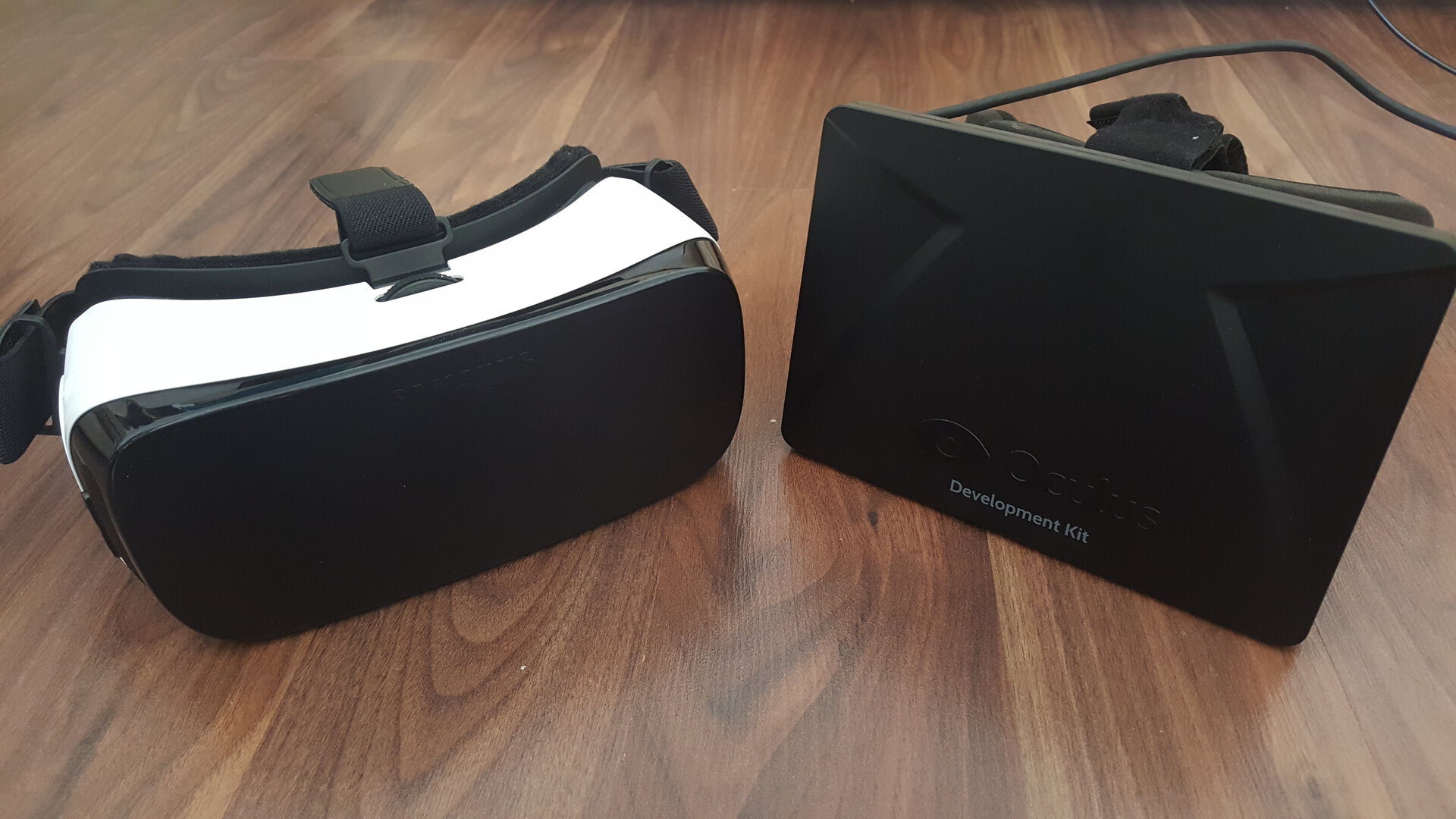
What you'll learn when exploring the official documentation is that when creating VR apps for the Gear, you are going to need the Oculus Mobile SDK. This provides packages, samples and other resource that you can use with Android Studio or Unity in gild to beginning edifice VR apps. The trouble is that you'll probable encounter all manner of problems getting it prepare and the help bachelor is lacking.
Fortunately, there'southward a much faster and easier style to build VR apps for the Gear which isn't yet described on the site: which is to utilise Unity 5without setting up the mobile SDK. This is possible because Unity actually now comes with Gear VR back up built-in. I highly recommend going this route as it will save you lot a lot of headaches and brand development much quicker and more than enjoyable.
Things still get a little fiddly though and seeing as the official guides don't embrace this, let's go over all the steps.
Creating a landscape
The quickest manner to get a feel for developing mobile VR apps is to create a terrain in Unity and so jump into it. Let'southward do that so…
If you're not familiar with how to set and become started in Unity, get acquainted with my introduction to Unity3D for easy Android game evolution and so check out the Android SDK setup documentation over at Unity3D.com. This will prove you how to use Unity with the Android SDK to create APK files.
Then you can begin creating a 3D landscape…
First, create a new 3D project. Now select GameObject > 3DObject > Terrain and you'll see a flat mesh inserted into your scene. This is your flooring! You could also cull a flat aeroplane and then add a texture. If you want to, y'all tin can also use the aforementioned process to add additional elements into the scene: such as cubes. To make those cubes act like boxes, use the 'Add together Component' push to add a 'RigidBody' (which gives the box physics) and a 'Box Collider' (which makes certain you tin can't only walk through it).

The dandy thing most Unity is that it makes everything incredibly straightforward for you. In order to make this random scene into a 'game' for case, you just need to add a ready-made script called 'FPSController'. To go access to this though, y'all first need to import it.
To practice this, go to assets, right click and select 'import parcel'. Now click 'Characters'. Later on a few seconds, you'll see a list of assets and will be able to select 'import'. This volition and so import all those useful things for you to apply in your game: including the FPSController.
Once everything is imported, yous'll find the script you're looking for in Assets > Characters > FirstPersonCharacter > Prefabs > FPSController. Simply elevate and drop this into your scene and you're practiced to become! Note that this controller includes its own photographic camera, and then if yous accept ane in your scene already (which you probably do past default) you can but delete it. Press Play and you should at present exist able to movement around your scene with the WASD keys and mouse! Yous tin can jump, look around and otherwise practice pretty much everything you'd expect in a 1st person game.
I've glossed over how to create your 3D scene considering this isn't actually a Unity tutorial – it'southward a VR tutorial. If you're not familiar with Unity, so y'all tin can find a great series of videos that will testify y'all how to practice all this in more than item hither (part ane below). Lookout up to Part iii and you'll exist adept to go!
Porting your FPS to Gear VR
As mentioned earlier, Unity five now supports Gear VR past default which makes life much easier for united states. That means that you don't need to install anything else on your PC – not even the Mobile SDK! Only make sure that you take the latest version of Unity installed and that it'due south prepare upwards for Android development. But while you don't need to mess around with the mobile SDK, what youpractise demand to do is a whole bunch of other fiddly things… pitiful!
To start with, y'all're going to need to ready your build settings correctly. To do this, head to file > build settings. Here you volition need to select 'Android' equally the platform and then prepare 'texture compression' to 'ETC2 (GES 3.0)'. You also need to drag your first scene (which you tin can probably find in the assets binder later you've saved) into 'Scenes in Build'.
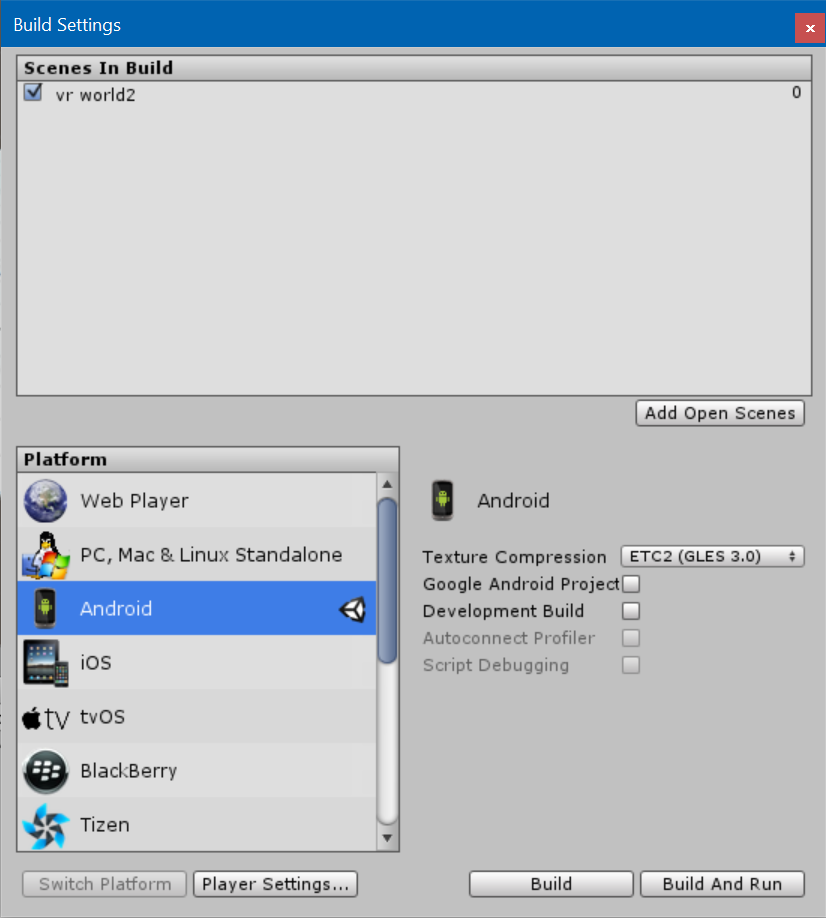
All this volition ensure that you're creating an app for Android that starts with the scene you've included. So far so good! Just at this point information technology's just an Android app, non a Gear VR app. To rectify that, click the push button that says 'Histrion Settings'.
At present you'll observe a bunch more options for compiling your game. You lot'll need to cull a company proper name and a product name and you'll need to set your package name following the usual conventions (com.CompanyName.AppName). Brand sure to set the minimum API level to 19 or above and create your keystore.
Possibly virtually important though is to click 'Virtual Reality Supported' under 'Other Settings'. This is the one step will automatically allow you to look around using the sensors in your phone and the Gear VR, while too splitting the brandish and applying the subtle warping event to account for the lens distortion. Y'all may besides want to tick 'Multithreaded Rendering' to improve performance.
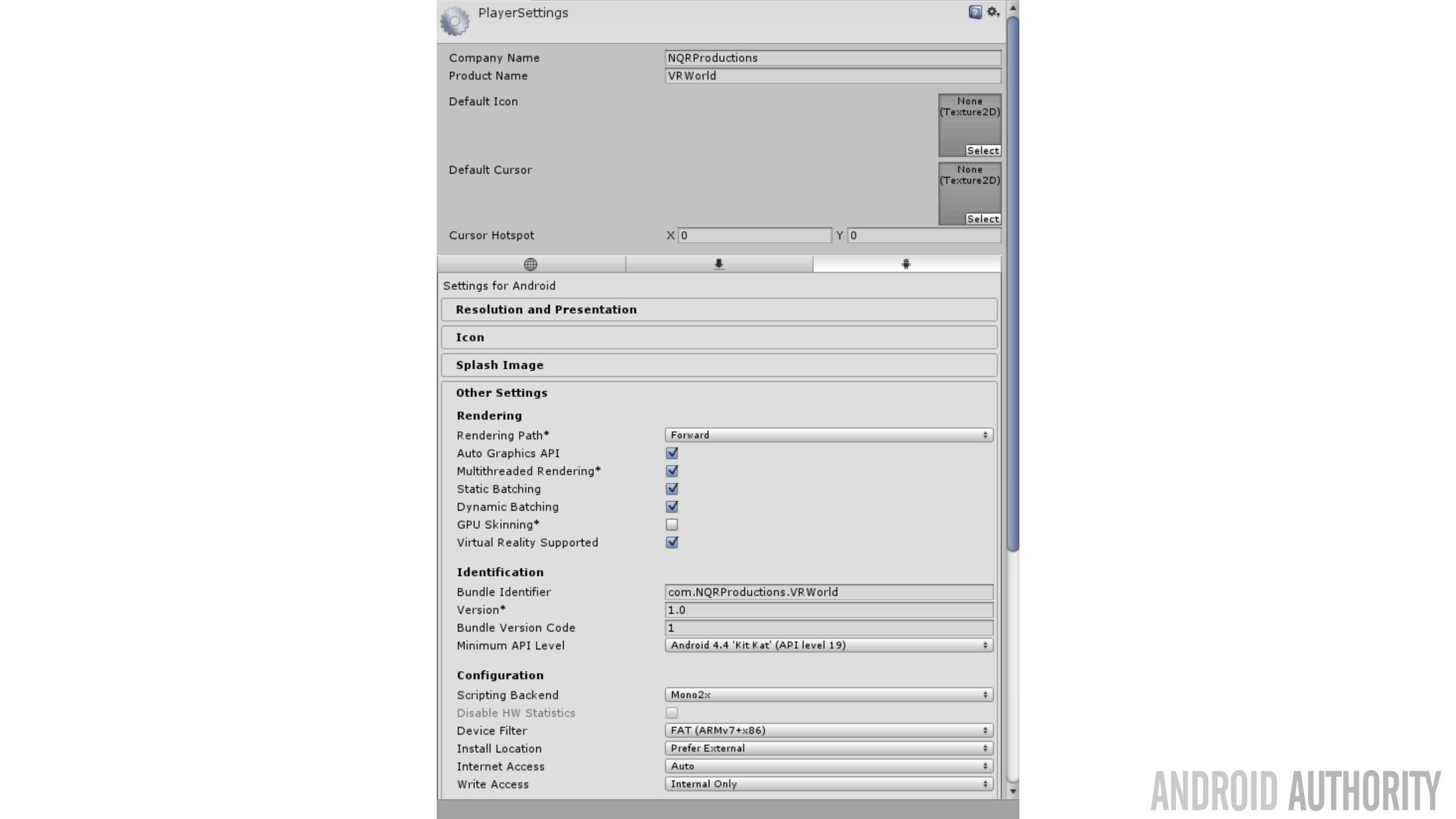
And that's really all it takes to make your app VR compatible! Oh and FYI, the touchpad is interpreted in just the same way equally a mouse – then you tin can apply mouse click to burn!
Creating an osig file
Unfortunately there'due south 1 more than ordeal you'll have to go through before y'all can bound in and try your app on your own device. That is: creating an .osig file (Oculus Signature File) so calculation it to your project. This step is a security mensurate implemented by Oculus to ensure that it can tightly command the types of experiences available on its device. It's a somewhat controversial motility as it makes developing, testing and distributing apps more difficult… merely it is what information technology is!
Basically, to run an app on any device, you lot first demand to 'sign' it using the device'south ID. To practise this, you accept to locate the device ID (not the serial number) which yous tin observe by plugging your device into your PC via USB and then entering 'adb devices' in a command window. You'll and then exist shown the ID of your device. Enter this here: https://programmer.oculus.com/osig/ so click 'Download File'. You'll also need to register as an Oculus developer if yous haven't already.

And at present you need to take your osig file and put it in a new directory inside your bundle. Specifically, that directory needs to exist: YourApp/Assets/Plugins/Android/assets/. You may not even have a Plugins folder yet, so you lot'll need to create a whole bunch of empty folders inside one another.
Note that this means you'll need to create a new APK with a new osig file every time you want to test your app on a unlike device until you've been accustomed onto the Oculus Store. That means you can't just upload it to Reddit to get some feedback.
Interestingly though, at that place is an app that has been designed to get effectually this chosen Sideload VR. This creates custom APKs based on your device's ID and lets y'all download some unique stuff not found in the official shop: including a VR version of Quake! You tin also use Sideload VR every bit a quicker way to grab your phone's ID.
Remember too that y'all will need to allow installations from external sources in society to test your app. Install the APK and then run information technology and information technology should prompt you to insert your phone into the Gear VR. If all has gone well, you're about to enter the earth you lot merely created!
The empty, boxy globe…
To recap on how nosotros did this:
- Fix Unity. Make sure it'south the latest version and that you've as well installed the Android SDK and Coffee JDK
- Create any 3D surround with a camera
- Set the platform to Android and texture compression to ETC2 (GES 3.0) in build settings
- Click 'player settings' and tick 'virtual reality supported' and 'multithreaded rendering'
- Create your package name and private keysign
- Create an osig file unique to your device and add it to: YourApp/Avails/Plugins/Android/assets/
- Create your APK and brand sure your device accepts apps from other sources
- Run your app and insert your device into the Gear VR!
Building Gear VR apps in Android Studio
Unity is most likely the best option for xc% of people wanting to create something quickly that incorporates 3D graphics. However, some of you might want to become the Android Studio route and in that instance yous will need the mobile SDK which y'all tin find hither.
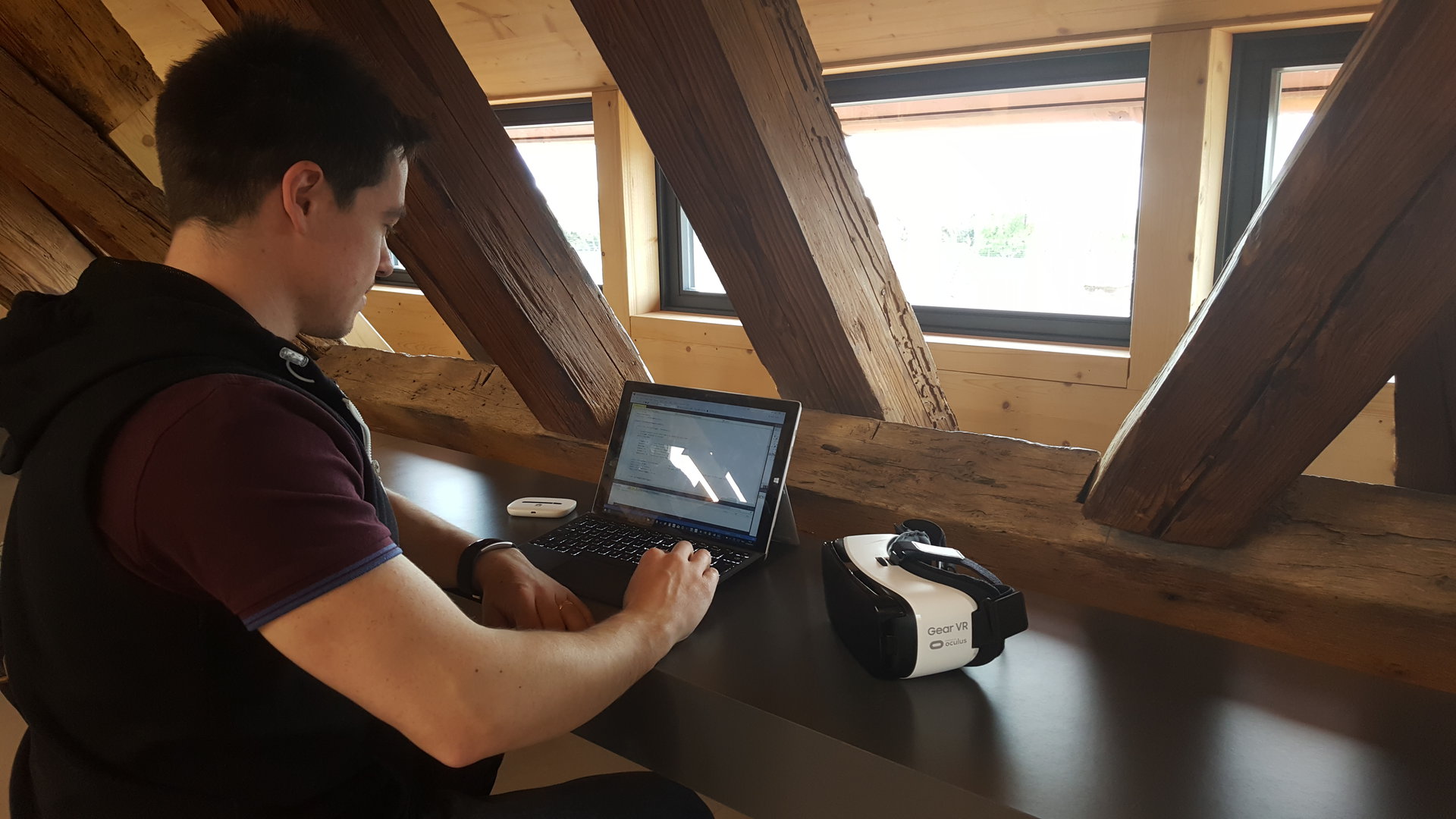
While some aspects of this are simpler than they used to be thanks to improvements to Android Studio, a lot of the information is one time once more out of date and the process ismuchmore fiddly overall. If yous do determine to brave information technology though, the best way to get started is to try out the samples. To use these, y'all are going to need to download and install the Android NDK. This is the 'Native Development Kit' which works similarly to the SDK but allows you to squeeze a little more than performance out of your device and use C++ in your code. Both of these things are useful for developing VR applications.
I highly recommend sticking with the Unity method unless yous have a very specific apply that requires otherwise.
Despite what the Oculus Documentation tells you though, you do non demand to download and unzip the massive NDK zilch file manually anymore. Instead, open Android Studio and go to File > Projection Structure > SDK Location. This is where you prepare the path for your SDK and JDK. And if yous look beneath those two, you lot'll see a blank field for the Android NDK location as well. Beneath this is a link that says 'Install'. Just striking that and the NDK-Bundle will be automatically downloaded and installed for you.
You lot tin can now import one of the projects from the Gear VR SDK and if you use the Gradle Wrapper and then everything will be set upwards for you including the dependencies etc. In theory at least… Just select the file called 'build.gradle' and let Android practise the rest.

From the official documentation
If you see errors, and so make sure that you lot take the latest versions of Android Studio, the JDK and Gradle gear up upwardly. You lot should too check the file chosen 'local.properties'. Make certain this is in the right location (wherever Android Studio says it's looking for information technology) and that information technology points to the correct location for your SDK and NDK.
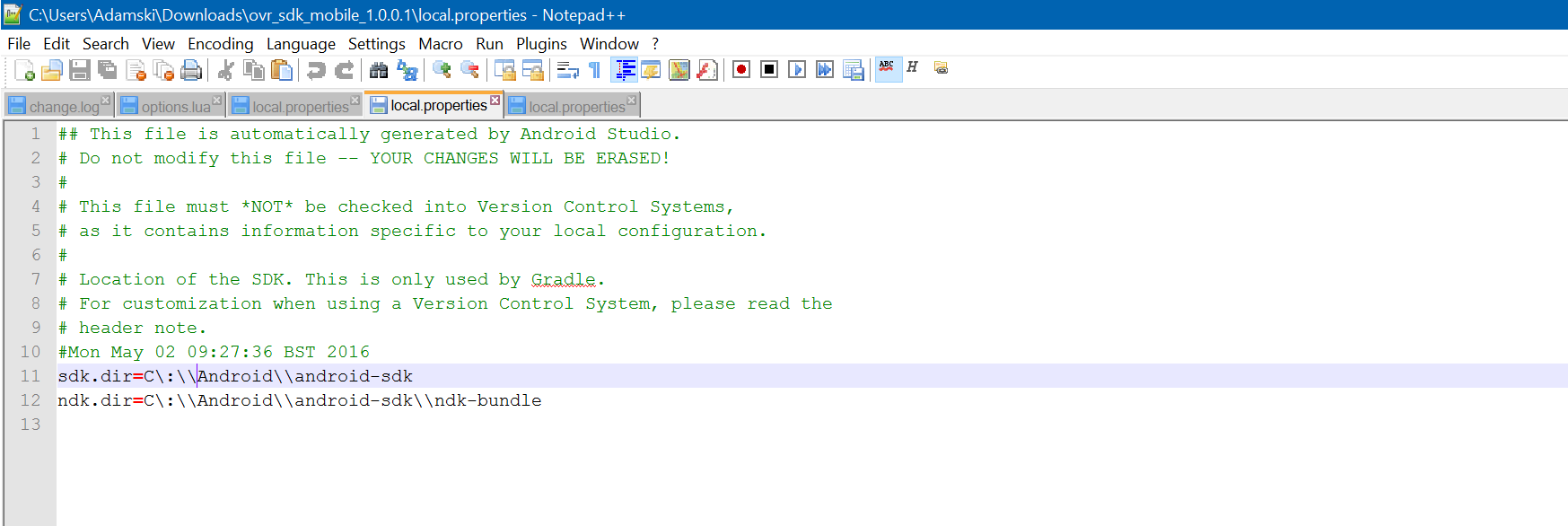
You might also want to manually check the dependencies. When I attempted this lots of paths were incorrect and it took a lot of squinting at my screen until I got everything working. Remember you too need to add together your osig file to the project before yous can take these samples for a spin. This time though you only have to place the osig inside Project/avails/.
Basically, you'll probably have to do a lot of problem shooting before everything runs smoothly. This gets very fiddly and back up is limited – seeing as the bulk of developers aren't using this method. Googling doesn't tend to yield many useful results. Even Oculus seems to exist leaning more towards the Unity route which makes sense seeing as I'one thousand struggling to remember of annihilation you might want to do that wouldn't be easier this style. So I highly recommend sticking with that method unless you have a very specific use that requires otherwise.
Conclusions
Using this method, creating apps for the Gear VR is very simple thanks to Unity and no thanks to the Oculus documentation/general lack of upward-to-appointment information. Fortunately, the Unity method is skillful for pretty much whatsoever type of app yous could exist planning to create – so stick with that and you shouldn't have too many problems!
At the terminate of the 24-hour interval, all you're actually doing is making a 3D game and then viewing it through your headset… but it feels similar and then much more than that. Being able to footstep into your creations completely changes the way you feel them and opens the doors for some incredible possibilities.
Yous don't need to be an skilful at using Unity to make something amazing either. In fact, most documentation recommends keeping graphics and effects to a minimum in order to ensure smooth frame rates (which take priority in VR). The big breakthroughs won't likely take anything to do with graphical fidelity but rather will change the fashion nosotros interact with our hardware and software.
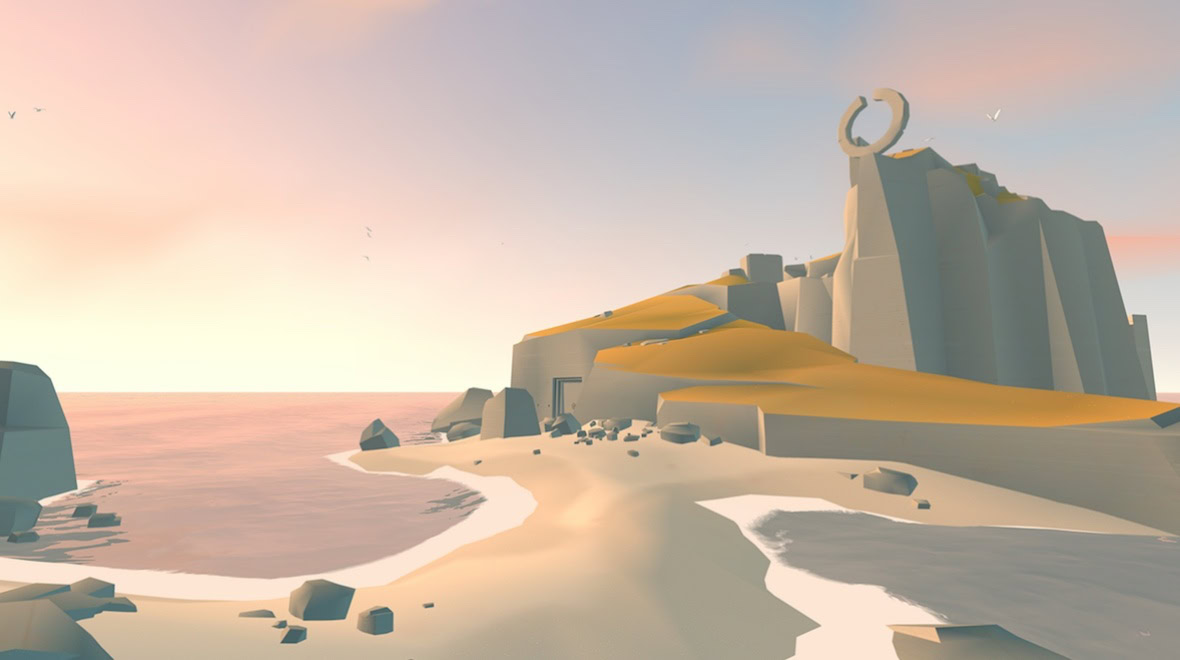
Don't make this, someone has already has (ustwo)
In short, you now have the ability to create unabridged virtual worlds. The question becomes: then, what are you going to create?
DOWNLOAD HERE
Best Public Speaking Apps for the Samsung Gear Vr UPDATED
Posted by: johnhatted1965.blogspot.com
Comments
Post a Comment